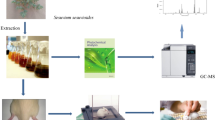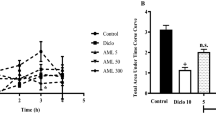Abstract
This study is devoted to the estimation of total bioactive contents and the evaluation of acute toxicity and in vivo anti-inflammatory effects and the assessment of in vitro antioxidant and anti-arthritic potential of the species Scabiosa stellata. The anti-arthritic activity was performed by bovine serum albumin denaturation method and the antioxidant activity was evaluated by eight different methods. Furthermore, the acute oral toxicity and the anti-inflammarory activity using the model of carrageenan-induced paw edema were tested on male Wistar rats. The ethyl acetate extract recorded the highest content of polyphenols, flavonoids and tannins. All the crude extracts (PE, EtAOc and n-BuOH) had antioxidant activities in various assays and prevent the denaturation of bovin serum albumin in dose depending manner. The oral administration of the ethyl acetate extract at various concentrations (500, 1000 and 2000 mg/kg), does not induce any toxic symptoms or mortalities in all the treated animals. No significant changes in biochemical and hematological parameters compared to the control group were observed. Thus, the approximate acute lethal dose 50 of this extract was higher than 2000 mg/kg. In addition, the administration of ethyl acetate extract at doses of 50 and 75 mg/kg prevents a significant acute paw edema and present a higher anti-inflammatory activity than Diclofenac as a positive control.




Similar content being viewed by others
References
Alaoui K, Lagorce JF, Cherrah Y, Hassar M, Amarouch H, Roquebert J (1998) Activité analgésique et anti-inflammatoire des saponines d’Argania spinosa. Ann Pharm Fr 56(5):220–228
Al-Qudah MA, Otoom NK, Al-Jaber HI, Saleh AM, Abu Zarga MH, Afifi FU, Abu Orabi ST (2017) New flavonol glycoside from Scabiosa prolifera L. aerial parts with in vitro antioxidant and cytotoxic activities. Nat Prod Res 31(24):2865–2874
Apak R, Güçlü K, Özyürek M, Karademir SE (2004) Novel total antioxidant capacity index for dietary polyphenols and vitamins C and E, using their cupric ion reducing capability in the presence of neocuproine: CUPRAC method. J Agric Food Chem 52(26):7970–7981
Bammi J, Douira A (2002) Medicinal plants in the forest of Achach (central plateau, Morocco). J Acta Bot Mal 27:131–145
Baykal T, Panayir T, Tasdemir D, Sticher O, Çalis I (1998) Triterpene saponins from Scabiosa rotata. Phytochemistry 48(5):867–873
Birben E, Sahiner UM, Sackesen C, Erzurum S, Kalayci O (2012) Oxidative stress and antioxidant defense. World Allergy Organ J 5(1):9
Blois MS (1958) Antioxidant determinations by the use of a stable free radical. Nature 181(4617):1199–1200
Bonet MÀ, Valles J (2007) Ethnobotany of Montseny biosphere reserve (Catalonia, Iberian Peninsula): plants used in veterinary medicine. J Ethnopharmacol 110(1):130–147
Boulos L (1997) Endemic flora of the middle east and North Africa. Rev Ecol Desert Conserv Dev 1:229–260
Bussmann RW, Glenn A, Meyer K, Kuhlman A, Townesmith A (2010) Herbal mixtures in traditional medicine in Northern Peru. J Ethnobiol Ethnomed 6(1):10
Christopoulou C, Graikou K, Chinou I (2008) Chemosystematic value of chemical constituents from Scabiosa hymettia (Dipsacaceae). Chem Biodivers 5(2):318–323
Csányi G, Miller FJJ (2014) Oxidative stress in cardiovascular disease. Int J Mol Sci 15(4):6002–6008
Decker EA, Welch B (1990) Role of ferritin as a lipid oxidation catalyst in muscle food. J Agric Food Chem 38(3):674–677
Elhawary SS, Eltantawy ME, Sleem AA, Abdallah HM, Mohamed NM (2011) Investigation of phenolic content and biological activities of Scabiosa atropurpurea L. World Appl Sci J 15(3):311–317
Fransworth NR (1966) Biological and phytochemical screening of plants. J Pharm Sci 55(3):225–276
Gan WQ, Man SFP, Senthilselvan A, Sin DD (2004) Association between chronic obstructive pulmonary disease and systemic inflammation: a systematic review and a meta-analysis. Thorax 59(7):574–580
Garaev EA, Movsumov IS, Isaev MI (2008) Flavonoids and oleanolic acid from Scabiosa caucasica. Chem Nat Compd 44(4):520–521
Gowda S, Desai PB, Kulkarni SS, Hull VV, Math AA, Vernekar SN (2010) Markers of renal function tests. N Am J Med 2(4):170
Hansson GK (2005) Inflammation, atherosclerosis, and coronary artery disease. N Engl J Med 352(16):1685–1695
Heimler D, Vignolini P, Dini MG, Vincieri FF, Romani A (2006) Antiradical activity and polyphenol composition of local Brassicaceae edible varieties. Food Chem 99(3):464–469
Hlila MB, Mosbah H, Mssada K, Ben Jannet H, Aouni M, Selmi B (2015) Acetylcholinesterase inhibitory and antioxidant properties of roots extracts from the Tunisian Scabiosa arenaria Forssk. Ind Crops Prod 67:62–69
Horn MM, Drewes SE, Brown NJ, Munro OK, Meyer JM, Mathekga AD (2001) Transformation of naturally-occurring 1,9-trans-9,5-cis-sweroside to all trans-sweroside during acetylation of sweroside aglycone. Phytochemistry 57(1):51–56
Hossein Zadeh H, Shakib SS, Sameni AK, Taghiabadi E (2013) Acute and subacute toxicity of safranal, a constituent of saffron, in mice and rats. IJPR 12(1):93
Hotta M, Ogata K, Nitta A, Hoshikawa K, Yanagi M, Yamazaki K (1989) Useful plants of the world. Heibonsha LTD, Tokyo
Ji M, Li SJ, Ma CM (2014) Chemical constituents of the inflorescence of Scabiosa comosa Fisch and their antioxide and α-glucosidase inhibitory activities. J Inner Mong Univ (Natural Science Edition) 4:398–403
Karthik K, Kumar BRP, Priya VR, Kumar SK, Rathore RSB (2013) Evaluation of anti-inflammatory activity of Canthium parviflorum by in vitro method. Indian J Res Pharm Biotechnol 1(5):729
Kerr S, Brosnan MJ, McIntyre M, Reid JL, Dominiczak AF, Hamilton CA (1999) Superoxide anion production is increased in a model of genetic hypertension. Hypertension 33(6):1353–1358
Kuril’chenko VA, Zemtsova GN, Bandyukova VY (1971) A chemical study of Scabiosa bipinnata. Chem Nat Compd 7(4):519
Le K, Chiu F, Ng K (2007) Identification and quantification of antioxidants in Fructus lycii. Food Chem 105(1):353–563
Lehbili M, Magid AA, Hubert J, Kabouche A, Voutquenne-Nazabadioko L, Renault JH, Nuzillard JM, Morjani H, Abedini A, Gangloffd SC, Kabouchea Z (2017) Two new bis-iridoids isolated from Scabiosa stellata and their antibacterial, antioxidant, anti-tyrosinase and cytotoxic activities. Fitoterapia 125:41–48
Levey AS, Coresh J, Greene T, Stevens LA, Zhang YL, Hendriksens S et al (2006) Using standardized serum creatinine values in the modification of diet in renal disease study equation for estimating glomerular filtration rate. Ann Intern Med 145(4):247–254
Mahjoub S, Masrour-Roudsari J (2012) Role of oxidative stress in pathogenesis of metabolic syndrome. Casp J Intern Med 3(1):386
Marco GJ (1968) A rapid method for evaluation of antioxidants. J Am Oil Chem Soc 45(9):594–598
Medini F, Fellah H, Ksouri R, Abdelly C (2014) Total phenolic, flavonoid and tannin contents and antioxidant and antimicrobial activities of organic extracts of shoots of the plant Limonium delicatulum. J Taibah Univ Sci 8(3):216–224
Noreen Y, Serrano G, Perera P, Bohlin L (1998) Flavan-3-ols isolated from some medicinal plants inhibiting COX-1 and COX-2 catalysed prostaglandin biosynthesis. Planta Med 64(6):520–524
Organization for Economic Co-operation and Development (2002) OECD guidelines for the testing of chemicals. Paris: Organization for Economic Co-operation and Development [Online]. Available from: http://www.oecd.org/chemicalsafety/testing/2741541.pdf
Oyaizu M (1986) Studies on products of browning reaction: antioxidative activity of products of browning reaction. Jpn J Nutr 44(6):307–315
Perdetzoglou D, Skaltsa H, Tzakou O, Harvala C (1994) Comparative phytochemical and morphological study of two species of the Scabiosa L. genus. Feddes Rep 105(3–4):157–165
Polat E, Alankus-Caliskan Ö, Karayildirim T, Bedir E (2010) Iridoids from Scabiosa atropurpurea L. subsp. maritima Arc (L.). Biochem Syst Ecol 38(2):253–255
Prieto P, Pineda M, Aguilar M (1999) Spectrophotometric quantitation of antioxidant capacity through the formation of a phosphomolybdenum complex: specific application to the determination of vitamin E. Anal Biochem 269(2):337–341
Quezel P, Santa S (1963) Nouvelle flore de l’Algérie et des régions désertiques méridionales, vols 1–2. In: CNRS (Ed), Paris, pp 892
Ramaiah SK (2011) Preclinical safety assessment: current gaps, challenges, and approaches in identifying translatable biomarkers of drug-induced liver injury. Clin Lab Med 31(1):161–172
Re R, Pellegrini N, Proteggente A, Pannala A, Yang M, Rice-Evans C (1999) Antioxidant activity applying an improved ABTS radical cation decolorization assay. Free Radic Biol Med 26(9):1231–1237
Sayre LM, Smith MA, Perry G (2001) Chemistry and biochemistry of oxidative stress in neurodegenerative disease. Curr Med Chem 8(7):721–738
Singh R, Singh S, Kumar S, Arora S (2007) Evaluation of antioxidant potential of ethyl acetate extract/fractions of Acacia auriculiformis A Cunn. Food Chem Toxicol 45(7):1216–1223
Sosa V, Moliné T, Somoza R, Paciucci R, Kondoh H, LLeonart ME (2013) Oxidative stress and cancer: an overview. Ageing Res Rev 12(1):376–390
Therond P (2006) Oxidative stress and damages to biomolecules (lipids, proteins, DNA). Ann Pharm Fr 64(6):383–389
Turkoglu A, Duru ME, Mercan N, Kivrak I, Gezer K (2007) Antioxidant and antimicrobial activities of Laetiporus sulphureus (Bull.) Murrill. Food Chem 101(1):267–273
Vane J, Botting R (1987) Inflammation and the mechanism of action of anti-inflammatory drugs. FASEB J 1(2):89–96
Verlaque R (1984) Etude biosystématique et phylogénétique des Dipsacaceae. I. Délimitation des Dipsacaceae à l’intérieur des Dipsacales, rapports avec les autres familles de l’ordre. Rev Gén Bot 91:81–121
Vinegar R, Schreiber W, Hugo R (1969) Biphasic development of carrageenin edema in rats. J Pharmacol Exp Ther 166(1):96–103
Wang J, Liu K, Xu D, Wang Q, Bi K, Song Y, Li J, Zhang L (2013) Rapid micropropagation system in vitro and antioxidant activity of Scabiosa tschiliensis grunning. Plant Growth Regul 69(3):305–310
Wannes WA, Marzouk B (2016) Research progress of Tunisian medicinal plants used for acute diabetes. J Acute Dis 5(5):357–363
Winter CA, Risley EA, Nuss GW (1962) Carragenin-induced oedema in hind paw of the rat as an assay for anti-inflammatory drugs. PSoc Exp Biol Med 111(3):544–547
Yagminas AP, Franklin CA, Villeneuve DC, Gilman AP, Little PB, Valli VE (1990) Subchronic oral toxicity of triethyl lead in the male weanling rat. Clinical, biochemical, hematological, and histopathological effects. Fundam Appl Toxicol 15:580–596
Yakubu MT, Akanji MA, Oladiji AT (2007) Hematological evaluation in male albino rats following chronic administration of aqueous extract of Fadogia agrestis stem. Pharmacogn Mag 3(9):34–38
Yamada Y, Kiyokawa S, Mizushima Y (1987) Non-steroidal anti-inflammatory drugs. Adverse effects of non-steroidal anti-inflammatory drugs. Nihon rinsho. Jpn J Clin Med 45(5):1102–1108
Yoon JH, Baek SJ (2005) Molecular targets of dietary polyphenols with anti-inflammatory properties. Yonsei Med J 46(5):585–596
Yu L, Haley S, Perret J, Harris M, Wilson J, Qian M (2002) Free radical scavenging properties of wheat extracts. J Agric Food Chem 50(6):1619–1624
Zemtsova GN, Bandyukova VA, Shinkarenko AL (1968) Quercetin diglucoside from the yellow Scabiosa. Pharm Chem J 2(12):180–678
Zheng Q, Koike K, Han LK, Okuda H, Nikaido T (2004) New biologically active triterpenoid saponins from Scabiosa tschiliensis. J Nat Prod 67(4):604–613
Acknowledgements
The authors wish to express thanks to the DGRSDT of the Algerian ministry of higher education and scientific research for providing a research grant (Project 8/u05/853).
Author information
Authors and Affiliations
Corresponding author
Ethics declarations
Ethical statement
The experimental protocol was approved by the Biology Discipline, Life Science of University of Batna-2, Algeria.
Conflict of interest
The authors declare no potential conflicts of interest with respect to the research, authorship, and/or publication of this article.
Electronic supplementary material
Below is the link to the electronic supplementary material.
Rights and permissions
About this article
Cite this article
Mouffouk, C., Hambaba, L., Haba, H. et al. Acute toxicity and in vivo anti-inflammatory effects and in vitro antioxidant and anti-arthritic potential of Scabiosa stellata. Orient Pharm Exp Med 18, 335–348 (2018). https://doi.org/10.1007/s13596-018-0320-3
Received:
Accepted:
Published:
Issue Date:
DOI: https://doi.org/10.1007/s13596-018-0320-3




